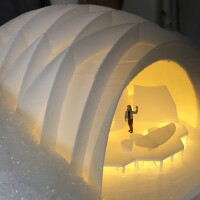Airplanes as Public Art in the Antelope Valley

Relive the excitement of man’s first steps on the moon and the long journey it took to get there with 20 new hours of out of this world programming on KCET's “Summer of Space" Watch out for “American Experience: Chasing the Moon” and a KCET-exclusive first look at "Blue Sky Metropolis," four one-hour episodes that examine Southern California’s role in the history of aviation and aerospace.
The high desert communities of the Antelope Valley are strongly associated with aviation. Sonic booms remain common, while much of the L.A. air traffic passes overhead, trailing behind white contrails. The space shuttle, stealth bomber, and stealth fighter all were built here; Chuck Jaeger broke the sound barrier here; unmanned drones that the U.S. uses for strikes all over the world were first developed here. Because of this — and because there are only so many ways one can draw a Joshua tree — aviation has a particularly indelible presence in the visual culture of the Antelope Valley. This includes murals on liquor stores, scale models in front of college campuses and folk art versions of rocket cars.
One aspect of public art one sees often here is the "airplane on a stick" — the elevation of a real, usually engine-less, plane via a plinth. These serve complicated and, at times, contradictory purposes. This article will tour sites and suggest five frameworks for interpretation.
1. Airplane as a Hair from the Tail of the Unicorn
Fine art achieves status in many ways, including by serving as a luxury good or rare object. A Renaissance Madonna has value in part due to the amount of lapis lazuli in the blue robes, or the quantity of gold leaf in the halo. Airplanes can be rare objects as well; Antelope Valley College's Douglas Skyrocket, the first plane to break Mach 2, is one of just three in the world.

This historic status is why it deserves attention, but I would like to suggest it could serve a different, separate role. During the Vietnam War, some of the campus faculty clashed with administration. While perhaps more common elsewhere, protests in the Antelope Valley were relatively rare. According to legend, at night the faculty would climb over the Skyrocket and paint peace signs and hippy flowers on it. In the view, the mounted plane could be a reminder of a moment of civil disobedience in our local history and a reminder of our first amendment rights.
2. Airplane as Visual Anchor.
Here is an airplane on a stick that anchors three axis lines at once.

This is the F4 Phantom on Lancaster Blvd., across from the Sherriff's Station. On a north-south line, it's the visual anchor for the Metrolink train, whose route out from Union Station ends here. On an east-west orientation, it ends the development called "the BLVD," that includes an aviation walk of fame.
This plane draws a third axis as well, one between memory and history, pride and concern. We saw earlier with the plane at Antelope Valley College, some people might see military technology as problematic, just by its very presence, and so for them, any plane may be inherently aggressive. Yet all planes -- just like all paintings -- exist in a context; in this case, this plane was our primary fighter during the Vietnam War.
In interviewing veterans for this article, I was told that seeing a plane from an era they served in could be a very positive experience. In seeing a plane (even while just driving by), they would remember bases they were stationed at, or recall people they once knew. The Phantom was used by the Marines, Navy, and Air Force, as well as by Israel and other allies, and in its time, was a record-setting, world-class plane, produced in greater numbers than any other US jet fighter.
Looking at it may mean little to some of us -- just another "airplane on a stick" -- but as a shape, as a piece of history, it means something to plenty of other people. That raises a question about public art: whose art, and which public? If the general population wants something immediate and unproblematic, what is art's responsibility to resist that or to satisfy it? More on these issues below.
There are more airplanes-on-a-stick yet coming; the Veterans' Home on 30th West is due for one in the next year or two. What if an airplane were installed upside-down or painted non-traditional colors? What if our next airplane was cast from clear resin — it was the right shape, but utterly transparent — and at night colored lights filled it up like the glow from a tropical lagoon? Could an airplane also be a planter, filled with flowers, or, better yet, "available to anybody" melons or strawberries?
The aerospace industry and the arts may not seem like friendly cohabitants. But, in our endeavor to activate the Antelope Valley through art, I hope we can create artworks that find a happy medium: between the aesthetic and the utilitarian, the highbrow and the low, and the celebrated and the shameful.

Read more about airplanes on a stick here.
Top Photo: Douglas D-558-2 Skyrocket at Antelope Valley College | Alan Wilson/Flickr/Creative Commons (CC BY-SA 2.0)


